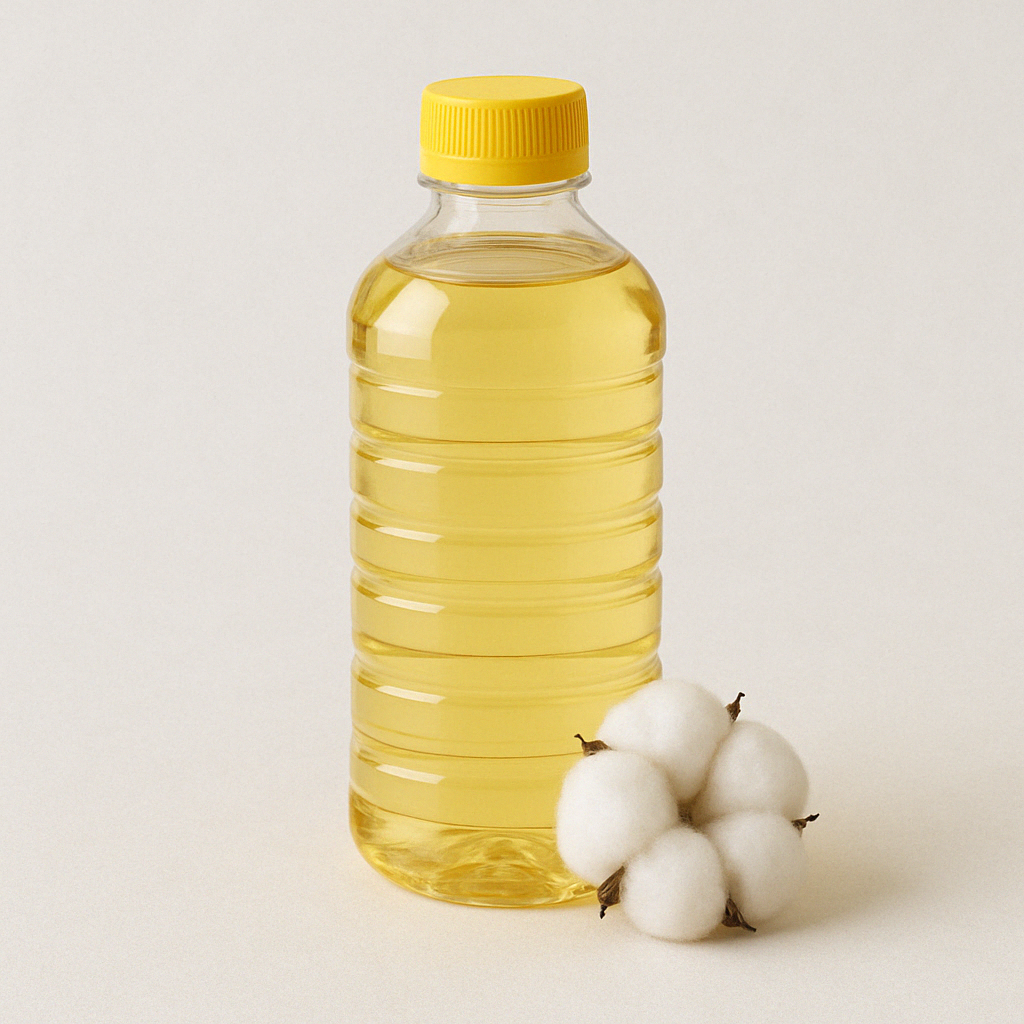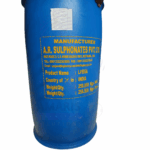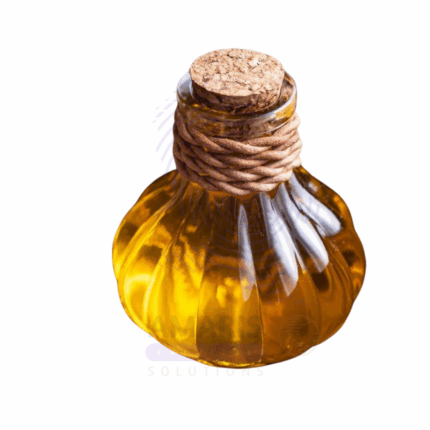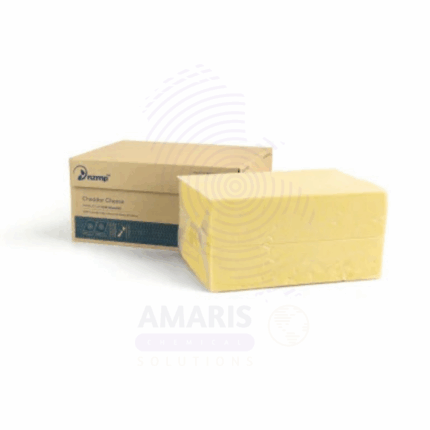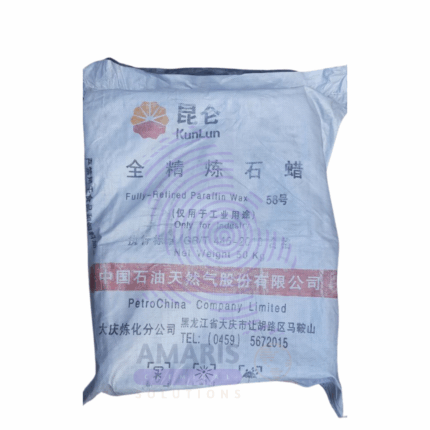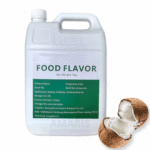
Cotton Seed Oil
Cotton Seed Oil is a light, odorless, vegetable oil extracted from the seeds of the cotton plant (Gossypium hirsutum and Gossypium herbaceum) through solvent extraction and refining processes. It is pale yellow with a neutral flavor, making it ideal for culinary, cosmetic, and industrial applications. Rich in polyunsaturated fatty acids, tocopherols, and antioxidants, Cotton Seed Oil is valued for its stability and high smoke point in cooking, as well as its emollient and conditioning properties in skin and hair care products.
In cosmetic formulations, it helps soften, nourish, and protect skin and hair, while in food production, it is used in frying oils, dressings, and snacks. Industrially, it finds applications in biodiesel production and soap manufacturing.
Cotton Seed Oil
Primary Uses
- Food and Beverage Industry
- Used as a cooking and frying oil due to its high smoke point and stability.
- Included in salad dressings, marinades, and mayonnaise for a light, neutral base.
- Common in snack food manufacturing, such as chips and crackers.
- Used in commercial baking for its non-dominant taste and shelf-stability.
- Blended with other vegetable oils in processed food products.
- Cosmetics and Personal Care
- Used as an emollient in lotions, creams, and moisturizers to soften and hydrate skin.
- Included in hair conditioners and treatments to restore shine and moisture.
- Used in lip balms and body oils for its lightweight texture and nourishing effect.
- Blended into soaps and bath oils for skin-conditioning and cleansing.
- Added to facial masks for its antioxidant and skin-replenishing benefits.
- Pharmaceuticals
- Used as a carrier oil in topical medicinal and herbal preparations.
- Employed in skin ointments and balms for its soothing and protective effects.
- Occasionally used as a base in massage oils and liniments.
Secondary Uses
- Pet Care Products
- Added to grooming formulations for moisturizing and coat-conditioning benefits.
- Used in paw balms to soothe and protect dry or cracked pads.
- Industrial Applications
- Used in soap production for its lathering and emulsifying properties.
- Applied in biodiesel production as a renewable feedstock.
- Utilized in textile and lubricant formulations as a base oil.
- Craft and DIY Formulations
- Popular in homemade skincare products such as salves and massage oils.
- Used in artisan soapmaking for its balance of cleansing and conditioning.
1. Basic Identification Attributes
- Botanical Name: Gossypium hirsutum, Gossypium herbaceum
- Common/Trade Name: Cotton Seed Oil
- INCI Name: Gossypium Herbaceum (Cotton) Seed Oil
- CAS Number: 8001-29-4
- HS Code: 1512.29
- Synonyms: Cotton Oil, Gossypium Seed Oil
2. Physical & Chemical Properties
- Physical State: Liquid vegetable oil
- Color & Odor: Pale yellow; mild or odorless
- Solubility: Insoluble in water; soluble in oils and alcohol
- Smoke Point: 420°F (216°C)
- Specific Gravity: 0.91–0.93
- Acid Value: < 1.0 mg KOH/g (refined)
- Main Components: Linoleic acid, oleic acid, palmitic acid, tocopherols
3. Safety & Hazard Attributes
- GHS Classification: Not classified as hazardous
- Toxicity: Non-toxic when properly refined and used
- Exposure Limits: None under normal conditions
- Allergen Information: Potential allergen for those sensitive to cotton-derived products
4. Storage & Handling Attributes
- Storage Conditions: Store in a cool, dry, and dark place
- Container Type: Food-grade drums or IBC containers
- Shelf Life: 12–18 months (refined); shorter for crude oil
- Handling Precautions: Avoid exposure to heat, light, and air to reduce oxidation
5. Regulatory & Compliance Attributes
- Approved for food use by FDA and EFSA (when fully refined)
- Compliant with cosmetic regulations (EU, ASEAN, USA)
- GRAS status for food applications
- Produced in GMP-certified facilities
6. Environmental & Health Impact
- Biodegradability: Biodegradable under natural conditions
- Ecotoxicity: Low environmental risk
- Bioaccumulation: Not expected
Safety Handling Precautions
- PPE Required: Gloves recommended during bulk handling
- Handling Guidelines: Keep sealed when not in use; use inert gas blanket if needed for bulk storage
First Aid Measures
- Inhalation: Not typically hazardous; move to fresh air if discomfort occurs
- Skin Contact: Generally safe; wash if irritation develops
- Eye Contact: Rinse with clean water if exposed
- Ingestion: Safe if food-grade; seek help if non-food-grade is ingested
Firefighting Measures
- Fire Hazards: Combustible at high temperatures
- Extinguishing Media: Foam, dry chemical, CO₂
- Special Precautions: Use full protective gear
- Hazardous Combustion Products: Carbon monoxide, carbon dioxide


 Preservatives(food)
Preservatives(food) Flavor Enhancers
Flavor Enhancers Acidulants
Acidulants Sweeteners
Sweeteners Antioxidants
Antioxidants Colorants(food)
Colorants(food) Nutraceutical Ingredients (food)
Nutraceutical Ingredients (food) Nutrient Supplements
Nutrient Supplements Emulsifiers
Emulsifiers
 Collectors
Collectors Dust Suppressants
Dust Suppressants Explosives and Blasting Agents
Explosives and Blasting Agents Flocculants and Coagulants
Flocculants and Coagulants Frothers
Frothers Leaching Agents
Leaching Agents pH Modifiers
pH Modifiers Precious Metal Extraction Agents
Precious Metal Extraction Agents
 Antioxidants(plastic)
Antioxidants(plastic) Colorants (Pigments, Dyes)
Colorants (Pigments, Dyes) Fillers and Reinforcements
Fillers and Reinforcements Flame Retardants
Flame Retardants Monomers
Monomers Plasticizers
Plasticizers Polymerization Initiators
Polymerization Initiators Stabilizers (UV, Heat)
Stabilizers (UV, Heat)
 Antifoaming Agents
Antifoaming Agents Chelating Agents
Chelating Agents Coagulants and Flocculants
Coagulants and Flocculants Corrosion Inhibitors
Corrosion Inhibitors Disinfectants and Biocides
Disinfectants and Biocides Oxidizing Agents
Oxidizing Agents pH Adjusters
pH Adjusters Scale Inhibitors( water)
Scale Inhibitors( water)
 Antioxidants(cosmetic)
Antioxidants(cosmetic) Emollients
Emollients Fragrances and Essential Oils
Fragrances and Essential Oils Humectants
Humectants Preservatives
Preservatives Surfactants(cosmetic)
Surfactants(cosmetic) Thickeners
Thickeners UV Filters
UV Filters
 Fertilizers
Fertilizers Soil Conditioners
Soil Conditioners Plant Growth Regulators
Plant Growth Regulators Animal Feed Additives
Animal Feed Additives Biostimulants
Biostimulants Pesticides (Herbicides, Insecticides, Fungicides)
Pesticides (Herbicides, Insecticides, Fungicides)
 Active Pharmaceutical Ingredients (APIs)
Active Pharmaceutical Ingredients (APIs) Excipients
Excipients Solvents(pharmaceutical)
Solvents(pharmaceutical) Antibiotics
Antibiotics Antiseptics and Disinfectants
Antiseptics and Disinfectants Vaccine Adjuvants
Vaccine Adjuvants Nutraceutical Ingredients (pharmaceutical)
Nutraceutical Ingredients (pharmaceutical) Analgesics & Antipyretics
Analgesics & Antipyretics
 Analytical Reagents
Analytical Reagents Solvents(lab)
Solvents(lab) Chromatography Chemicals
Chromatography Chemicals Spectroscopy Reagents
Spectroscopy Reagents microbiology-and-cell-culture-reagents
microbiology-and-cell-culture-reagents Molecular Biology Reagents
Molecular Biology Reagents Biochemical Reagents
Biochemical Reagents Inorganic and Organic Standards
Inorganic and Organic Standards Laboratory Safety Chemicals
Laboratory Safety Chemicals Specialty Laboratory Chemicals(Special Laboratory Equipment)
Specialty Laboratory Chemicals(Special Laboratory Equipment)
 Demulsifiers
Demulsifiers Hydraulic Fracturing Fluids
Hydraulic Fracturing Fluids Scale Inhibitors(oil)
Scale Inhibitors(oil) Surfactants(oil)
Surfactants(oil) Drilling Fluids
Drilling Fluids
 Dyes and Pigments
Dyes and Pigments Bleaching Agents
Bleaching Agents Softening Agents
Softening Agents Finishing Agents
Finishing Agents Antistatic Agents
Antistatic Agents
 Admixtures
Admixtures Waterproofing Agents
Waterproofing Agents Sealants and Adhesives
Sealants and Adhesives Curing Compounds
Curing Compounds Concrete Repair Chemicals
Concrete Repair Chemicals Anti-Corrosion Coatings
Anti-Corrosion Coatings
 Surfactants(cleaning)
Surfactants(cleaning) Builders
Builders Enzymes
Enzymes Solvents (Cleaning)
Solvents (Cleaning) Fragrances
Fragrances
 Electronic Chemicals
Electronic Chemicals Catalysts
Catalysts Lubricants
Lubricants Photographic Chemicals
Photographic Chemicals Refrigerants
Refrigerants Automotive chemicals
Automotive chemicals Pyrotechnic Chemicals
Pyrotechnic Chemicals
 Biodegradable Surfactants
Biodegradable Surfactants Bio-based Solvents
Bio-based Solvents Renewable Polymers
Renewable Polymers Carbon Capture Chemicals
Carbon Capture Chemicals Wastewater Treatment Chemicals
Wastewater Treatment Chemicals
 Pigments
Pigments Solvents(paint)
Solvents(paint) Specialty Coatings
Specialty Coatings Binders/Resins
Binders/Resins Additives
Additives Driers
Driers Anti-Corrosion Agents
Anti-Corrosion Agents Functional Coatings
Functional Coatings Application-Specific Coatings
Application-Specific Coatings
 Fresh Herbs
Fresh Herbs Ground Spices
Ground Spices Whole Spices
Whole Spices Spice Blends
Spice Blends Dried Herbs
Dried Herbs
 Leavening Agents
Leavening Agents Dough Conditioners
Dough Conditioners Flour Treatments
Flour Treatments Fat Replacers
Fat Replacers Decoratives
Decoratives Preservatives(baking)
Preservatives(baking)
 Plasticizers & Softeners
Plasticizers & Softeners Reinforcing Agents
Reinforcing Agents Adhesion Promoters
Adhesion Promoters Vulcanizing Agents
Vulcanizing Agents Antidegradants
Antidegradants Blowing Agents
Blowing Agents Fillers & Extenders
Fillers & Extenders Accelerators & Retarders
Accelerators & Retarders